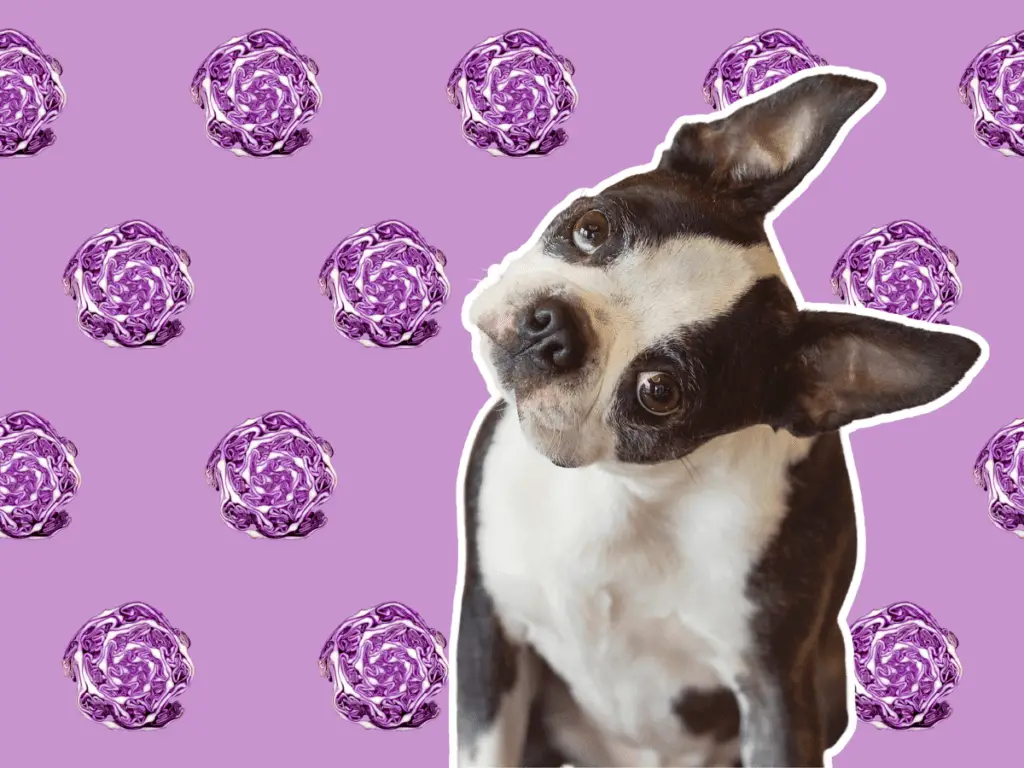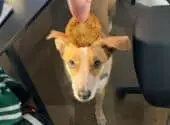If you’ve wondered about whether to feed your dog cabbage, we urge you to consider this crunchy veggie. Want your dog to have a great immune system or lose weight? Cabbage can help!
Cabbage has numerous health benefits that cannot be ignored. In particular, it contains large amounts of beta-carotene and vitamins C and K. These nutrients can help reduce the risks of many cancers.
This veggie is even great for your dog’s weight loss and skin. So serve it often!

Can Dogs Eat Cabbage?
The answer is a resounding yes! Cabbage is one of the best vegetables for dogs because it’s high in fiber and is packed with vitamins and minerals. Red cabbage, in particular, is effective at preventing certain cancers.
Cabbage also contains high levels of potent antioxidants called phytonutrients. These polyphenol chemicals give cabbage its high antioxidant content, making it one of the most nutritious vegetables for dogs. Your dog may develop different illnesses as it ages, including cancer, heart disease, arthritis. Polyphenols can be used to prevent the onset of these conditions and maintain your dog’s health.
One additional benefit is that cabbage helps promote a healthy digestive system in dogs. It is loaded with insoluble fibers, which help add bulk to stools and assist with regular bowel movements. More importantly, it contains soluble fibers, which have been found to increase the number of good bacteria in the gut. These include bifidobacteria and lactobacillus.
It’s always good to give your dog some healthy human foods like cabbage now and then. Cabbage is not just safe for your dogs to eat; they like it! They can eat it raw, cooked, or even baked. You can offer it alone as a green treat, chop it up and serve it with their kibbles, stuff it into meatloaf, or even bake it and fill it with other tasty treats.
You can also include it along with other green vegetables such as lettuce and kale in your dog’s healthy treat allotments, which veterinarians recommend as less than 10 percent per day.
Are Cabbage Leaves Low in Calories?
Dogs who are overweight may face several health risks. These include osteoporosis, pancreatitis, urinary cancer, and mammary cancer. However, these can all be prevented if you control your dog’s calorie intake. Luckily, cabbage contains very low calories, only around 33 per serving.
Previously, a research team found that the onset of osteoporosis, an often painful and sometimes debilitating disease for many large breed dogs, was postponed significantly by reducing their calorie intake. Calorie restrictions also delayed the onset and progression of other conditions.
Can Dogs Eat All Types of Cabbage?
All types of cabbage are suitable for your dog. Red cabbage is the best choice because it has the most nutrients. It provides your dog with high amounts of fiber, manganese (which helps build strong bones), copper (for healthy skin) and potassium (to keep his heart healthy).
Green cabbage is high in water, so it might be the best option if your dog tends to get dehydrated.
Bok choy is another good one. Again, it’s low in calories but high in vitamins.
How to Safely Feed Cabbage to Your Dog
Introducing cabbage to dogs at an early age may be beneficial because it helps them develop a taste for vegetables. Introducing cabbage to dogs at an older age may be tricky since they’ve already developed a taste for meat. So ask your veterinarian for advice.
Can dogs eat raw cabbage? While small amounts of raw cabbage may not cause problems for your dog, cooked cabbage is much easier to digest, especially if they’re not mixed with onion or garlic. In addition, thiocyanates can be found in raw cabbage, so deactivating the effects of this compound through cooking is best.
But remember: Cabbage leaves are so thick and leathery that even after cooked, they still pose a choking risk and may also cause digestive issues. So after cooking this vegetable, cut it into small pieces; then chop them into even smaller pieces.
The way you prepare the cabbage for your dog is just as important to avoid choking. Below are some easy ways to prep cabbage for your pup:
Blanching: To cook cabbage, boil it briefly in water, then quickly transfer it to an iced water basin. This method keeps its nutrients and flavor intact.
Steaming: Cabbage cooked by steaming retains its vibrant green color and preserves most of its nutrients.
Freezing: Cabbage freezes well, so if you cook a lot of cabbage at once, store some of it in the fridge for later use. When it’s time to feed your dog, take out one of the frozen containers from the refrigerator and heat it in the microwave. It takes less than five minutes to prepare.

Is Cooked Cabbage Better Than Raw Cabbage?
Raw and cooked cabbage is safe for dogs and offers them lots of nutrition. Most people who own dogs choose to cook cabbage for them because that is better for their pets’ overall wellness.
Boil or steam your cabbages in a pot of hot (not boiling) water is an effective way to feed your dog cabbage. On the other hand, serving him too much raw cabbage could be dangerous because he might choke on one.
Are There Dangers Associated with Dogs Eating Cabbage?
Cabbage is one of the most nutritious vegetables given to dogs, but it has some potential risks if eaten in large quantities. If you feed your dog too much cabbage, they may experience symptoms like excessive gas and diarrhea.
That’s why even if something is healthy for dogs (and people), it doesn’t necessarily mean they should be given as much as they want; always consult your vet first when giving your pet anything that might be considered “human food”. When introducing a new food into your dog’s diet, always give them a small portion first and observe their reaction for at least 24 hours before increasing the quantity.
In addition, if you allow your dog to consume large amounts of raw cabbage, one significant risk is that it could lead to hypothyroidism. But this is unlikely to occur if you control your dog’s raw cabbage intake.
Additionally, thiocyanate is a natural compound found in cabbage that affects the thyroid glands. However, if you boil or steam the cabbage beforehand and then offer it to your dog, you can effectively get rid of the compound.
Cabbage is safe to feed your dog in moderation, but cooking it makes it easier for your dog to consume and helps protect against the slight risks associated with feeding raw cabbage. Always prepare cabbage without any added seasonings or other ingredients that might not be suitable for dogs. Of course, your dog probably doesn’t care if the cabbage has been seasoned or not.
What Other Vegetables Can Dogs Eat Besides Cabbage?
Try out some approved vegetables to see if they’re good for your dog.
Carrots: According to the ASPCA, carrots are an ideal snack because they’re easy to eat raw, contain no fat, and don’t cause digestive issues. They also provide vitamins B, C, D and E, plus lots of fiber.
Sweet Potatoes/Yams: A star player in digestive health! Sweet potato has lots of fibre, not to forget vitamins B6 and C for brain health. It contains beta carotene, which helps improve eyesight and skin.
Cauliflower: Cauliflower is low in calories and high in fiber, so it’s an excellent source of nutrients. It contains vitamin B, which helps keep bones strong; vitamin C, which boosts immunity; and omega-3 fatty acid, which supports heart health.
Broccoli: Broccoli is one of the healthiest vegetables around. It contains vitamin C, folate, potassium, calcium, iron and magnesium. Plus, it’s low in calories and high in fibre. Chop it into small pieces, so it fits better in your pet’s tummy.
Zucchini: Zucchini strengthens your pet’s bones, heart and kidneys by providing them with calcium, vitamin A, and potassium. Note that steaming zucchini helps retain nutrients.
Green Beans: Serve them raw if you want, but don’t overcook them! They’re good for dogs, who need fiber, folate, and vitamins A, C, and K.
Spinach: Spinaches rich in iron and magnesium, vitamins A, C and E, plus fighting off cancer, heart disease and inflammation, makes it a wonderful vegetable for dogs.
Potatoes: This vegetable can definitely be eaten by dogs, but raw potatoes may not be ideal. Steaming and pureeing or baking a potato before serving it is advised.
Butternut Squash: If your pet needs foods rich in vitamins A, B6 and C to improve his immune system or heart health, choose butternut squash. Butternut squash is low in calories, high in nutrient content and easier on the stomach.
Beets: Root vegetables are good for dogs’ health because they contain vitamins and minerals that promote coat and digestive health. Beets are especially beneficial because they provide high amounts of vitamin C, folate, manganese, and magnesium.
Kale: Kale is a great food for several reasons. First, it helps build strong bones. Second, it can help improve your dog’s eyesight. Third, it can increase their immune system. Fourth, it provides iron, an essential nutrient for healthy red cell production and oxygen absorption.
Can Dogs Eat Cabbage? Our Verdict
Your dog can certainly eat cabbage. It contains vitamins B1, B6 and C and tons of phytonutrient antioxidants. These nutrients improve the overall health and wellness of dogs that consume them.
Related Questions
Can dogs eat cooked cabbage?
Of course, dogs can eat cooked cabbage. Feeding your dog cooked cabbage is more recommended than raw cabbage. Savoy cabbage, Red cabbage, Brussels sprouts and Bok Choy are some of the most common types of cabbage given to dogs.
What happens if my dog overeats cabbage?
Thiocyanate is a natural compound present in cabbage. If fed in excess amounts, it can cause your dog’s thyroid gland to become under-active, which can result in hypothyroidism.
What can dogs not eat?
Some foods are safe for humans but not necessarily safe for pets. Here are some examples:
Rhubarb: Oxalate is found in rhubarb, which can be harmful to dogs if consumed in large quantities. It can lower the levels of minerals in your dog’s body, leading to kidney damage and other health issues.
Mushrooms: You can feed store-bought mushrooms to your dog, but don’t feed wild ones because they might contain toxins.
Persimmons, Cherries, Apricots, Plums, Peaches: If your dog eats any of these fruits, it may experience small intestine inflammation.
Onions, Garlic, and Chives: These aromatics can harm dogs’ blood cell count, leading to the low iron content and kidney damage.
Grapes, Raisins, Currants: Even a small number of these fruits can be dangerous for dogs’ kidneys.
References
Candellone, A., Cerquetella, M., Girolami, F., Badino, P., & Odore, R. (2020). Acute diarrhea in dogs: current management and potential role of dietary polyphenols supplementation. Antioxidants, 9(8), 725.
Panciera, D. L. (1999). Is it possible to diagnose canine hypothyroidism? Journal of Small Animal Practice, 40(4), 152-157.
Erdoǧan, M. F. (2003). Thiocyanate overload and thyroid disease. Biofactors, 19(3,4), 107-111.




